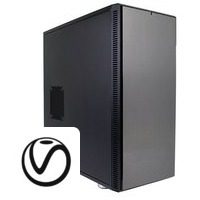Table of Contents
Introduction
Here at Puget Systems, specifically in the Labs department, most of the content that we write falls into one of two categories: either long, fairly in-depth articles looking at the performance of various PC components in a given application or recommended system pages, with multiple configuration options aimed at different budgets and lots of supporting data drawn from the aforementioned articles. For some readers all of that is information overload, though, and they just want a quick question answered: what is the best computer for my needs? We’re going to try answering that question more directly in a new series of short articles, like this one.
Today we are looking at V-Ray Next from Chaos Group, and specifically the GPU based side of this rendering engine. As applications go, it is pretty simple in its needs: video cards – the more and the faster the better, with lots of VRAM. These recommendations will also apply to older versions of V-Ray, as long as you are using the GPU processing side of things (we have another article for the CPU side).
Screenshot of V-Ray Next Benchmark
Good PC Configuration for V-Ray Next GPU
We'll start off with a good, solid workstation design for V-Ray Next – hopefully without breaking the bank. Compared to other GPU-based rendering engines we have tested, V-Ray Next benefits far less from higher-end video cards (at least with the same amount of VRAM) but it does scale very well with multiple cards. To start off, then, we have a tower that supports three GPUs with AMD's Threadripper processor platform. This is a bit overkill on the CPU side, but allows us to get up to three video cards without compromising on PCI-Express lanes; the more consumer-oriented platforms either max out at two GPUs or start restricting PCI-E lanes to 4x speeds in order to sneak in a third card. V-Ray Next does also allow the CPU to be used alongside the video cards, in a sort of GPU-emulation, but the performance gained there is not nearly as cost-effective as having more real video cards. To round the system out we have 64GB of memory, a fast SSD for the OS, applications, and project files, and a hard drive for storage of finished projects.
| CPU | AMD Threadripper 3960X 24-core |
| Video Cards | 3x NVIDIA GeForce RTX 2060 SUPER |
| RAM | 64GB DDR4 |
| Drives | 1TB NVMe SSD + 4TB SATA HDD |
Configure System With These Specs
Better PC Configuration for V-Ray Next GPU
Our most popular workstations for V-Ray Next GPU bump the video card count up to four and move to using the top model in NVIDIA's GeForce RTX series: the 2080 Ti, with 11GB of graphics memory. That also requires moving to a motherboard with support for more PCI-Express slots and a bigger power supply, and with all of these expensive components a longer warranty is a good idea as well.
| CPU | Intel Xeon W-2235 6-core |
| Video Cards | 4x NVIDIA GeForce RTX 2080 Ti |
| RAM | 64GB DDR4 ECC Registered |
| Drives | 1TB NVMe SSD + 4TB SATA HDD |
Configure System With These Specs
Best PC Configuration for V-Ray Next GPU
Maxing-out GPU rendering performance in V-Ray Next means going up to four of the biggest video cards NVIDIA makes right now, which are the Quadro RTX 8000 that have a massive 48GB of memory each. This may be overkill for most folks, and the RTX 6000 is just as fast but with less VRAM (24GB per card) if you want to save some money.
| CPU | Intel Xeon W-2295 18-core |
| Video Cards | 4x NVIDIA Quadro RTX 8000 |
| RAM | 256GB DDR4 ECC Registered |
| Drives | 1TB NVMe SSD + 4TB SATA HDD |
Configure System With These Specs
That is the most powerful traditional, tower workstation that we can build for V-Ray Next GPU right now, but there are other ways to move beyond even this powerhouse of a PC. For example, if this were going to be a server-style system that was accessed remotely, you could go with a rackmount chassis and potentially fit more than four video cards. V-Ray also supports distributed network rendering, so you could split out processing across several systems in either an office or server farm.
Additional Resources
If you want to know more about V-Ray Next performance, we have published several articles over the years looking at how individual GPUs compare as well as how well this software scales across multiple cards. And if you aren’t sure what you need, or if your workflow includes multiple applications, please feel free to call or email our consultants to get a more personalized configuration.
Puget Systems offers a range of powerful and reliable systems that are tailor-made for your unique workflow.

